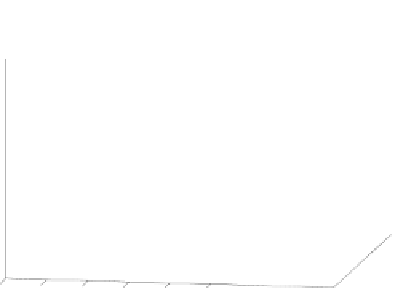Information Technology Reference
In-Depth Information
displacement was at the 9
◦
radius, which was not included in the calculation of error
statistics.
2.3.3
Final Error in Pixels
Although the final errors in configuration space given in Section 2.3.2 seem more
that adequate, a more insightful measure of efficacy is the final error in pixels. Be-
cause perspective cameras were used, the distance of the objects from the camera
play a significant role in how the objects move, and consequently, the magnitude of
change in the kernel projected value under camera motions. The number of pixels
per unit of motion was determined using the set of collected images from Section
2.3.1 by following a point during motion in each of the degrees of freedom.
For the 2D experiments, the plane containing the object was at a distance such
that the relationship between robot motion and image motion was approximately
2 mm/pixel. From Table 2.1 we see that the maximum error was on the order of a
pixel and the average error was approximately a half of a pixel.
For the depth experiments, the plane containing the object was at a distance such
that the relationship between the robot depth motion and the image motions was
approximately 4 mm/pixel. From Table 2.2 we see that the maximum error was
about one-third of a pixel and the average error was approximately one-tenth of a
pixel.
For the rigid body rotation experiments, the results were very promising in terms
of pixel error. Because the image is the result of a spherical projections, the pixel
error changes depending on whether it is measured near the center of the image or
Ta b l e 2 . 2
Error measurements for the fifty depth experiments
Average Error
σ
Error
Max Error
Min Error
z
0
.
3708 mm
0
.
2864 mm 1
.
2163 mm 0
.
0203 mm
0.2
0.15
0.1
0.05
0
−0.05
−0.1
−0.15
0.5
−0.2
0
−0.25
−0.5
−0.2
−0.15
−0.1
−0.05
0
0.05
0.1
0.15
0.2
Fig. 2.9
Convergence results for the 50 trials of rigid body rotations








































































































































































































































































































































































































































































































































































































































































































































































































































































































































































































































































































































































































































































































































































































































































































































































































































































































































































































































































































































































































































































































































































































































































































































































































































































































































































































































































































































































































































































































































































































































































































































































































































































































































































































































































































































































































































































































































































































































































































Search WWH ::

Custom Search